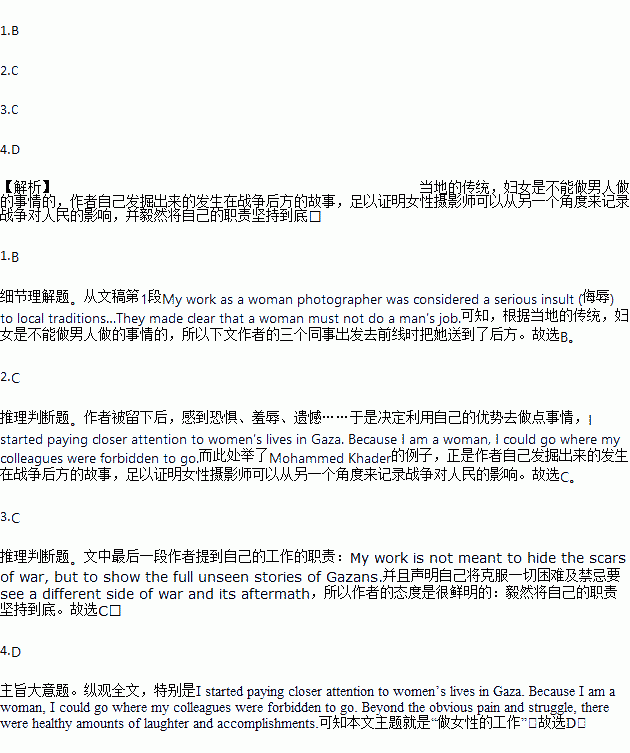题目内容
THIS is an adapted excerpt(摘录)from Eman Mohammed’s speech at TED (Technology, Entertainment and Design), a non-profit conference, in 2014. She is one of the few female photo journalists in the Gaza Strip(加沙地带).
When I was 19, I started my career as the first female photojournalist in the Gaza Strip, Palestine. My work as a woman photographer was considered a serious insult(侮辱)to local traditions. The male-dominated profession made me feel unwelcome by all possible means. They made it clear that a woman must not do a man’s job. Photo agencies in Gaza refused to train me.
Three of my colleagues went as far as to drive me to an open air strike area where explosions were the only thing I could hear. Dust was flying in the air, and the ground was shaking beneath me. I only realized we weren’t there to document the event when the three of them got back into the armored(装甲的)Jeep and drove away, waving and laughing. Leaving me behind in the open air strike zone.
For a moment, I felt terrified, humiliated, and sorry for myself.
I started paying closer attention to women’s lives in Gaza. Because I am a woman, I could go where my colleagues were forbidden to go. Beyond the obvious pain and struggle, there were healthy amounts of laughter and accomplishments.
In front of a police compound in Gaza City during the first war in Gaza, an Israeli air raid(袭击)destroyed the compound and broke my nose. For a moment, all I saw was bright white. I thought I had either gone blind or I was in heaven. By the time I managed to open my eyes, I had documented this moment.
Mohammed Khader is a Palestinian worker who spent two decades in Israel. As his retirement plan, he decided to build a four-floor house. By just the first field operation(军事行动)in his neighborhood, the house had been flattened. Nothing was left but the pigeons he raised and a bathtub. Mohammed put the bathtub on the top of the rubble(瓦砾)and started giving his kids a bobble bath every morning.
My work is not meant to hide the scars of war, but to show the full unseen stories of Gazans. As a Palestinian female photographer, the journey of struggle, survival and everyday life has inspired me to overcome the community taboo(禁忌)and see a different side of war and its aftermath(灾祸). I became a witness with a choice: to run away or stand still.
1.The author couldn’t work with her colleagues in the Gaza Strip because _______.
A. she hadn’t received the training offered by the photo agency there
B. the local traditions didn’t allow a woman to do a man’s job
C. her colleagues were going to take part in the battle
D. she was terrified of explosions in the air strike area
2.The author used Mohammed Khader as an example to ______.
A. prove there was pain as well as laughter during the war
B. show how dangerous the surroundings were in Gaza
C. show that she could document common people’s lives at the war
D. let the reader know how the war influenced her life
3.From the story, it can be inferred that ________.
A. the author wouldn’t like to reveal the cruel side of war
B. the author eventually had to leave Gaza because of the community taboo
C. the author decided to document more unseen scenes from the war
D. the author was determined to run away from the explosions in the end
4.The best title of the passage is _____.
A. An Insult To Local Traditions B. Run away or Stand Still
C. Laughter During the War D. Do Women’s Work
 天天向上一本好卷系列答案
天天向上一本好卷系列答案 小学生10分钟应用题系列答案
小学生10分钟应用题系列答案

 l watchers.
l watchers. old on to tradition,and this also 9..(silent) marks them out from “the rest”.However,as for William and Kate,the 10..(decide) to dress George in shorts is more likely down to tradition than a class issue.
old on to tradition,and this also 9..(silent) marks them out from “the rest”.However,as for William and Kate,the 10..(decide) to dress George in shorts is more likely down to tradition than a class issue.